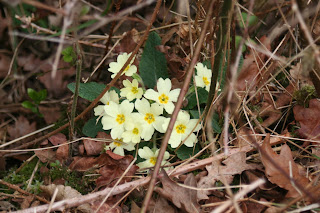As Spring turns slowly to early Summer, so the swathes of Cowslips, Cuckoo Flower and Marsh Marigold that typify the peatbank in April give way to a lush green carpet of Blunt-flowered Rush and smaller, grey-green sedges, such as Carnation Sedge, interspersed with swathes of Southern Marsh Orchid, Ragged Robin and Hay Rattle, for which the reserve is well known.

The peatbank consists of a 5 – 6 feet deep layer of waterlogged peat over gravel and clay. There are a number of springs emanating out of the lower slopes and flushing out into the sedgebeds, helping to maintain their wetness. At some time in the past, attempts were made to drain the peatbank for grazing by digging ditches in line with these springs. The ditches fed into a main drain at the foot of the peatbank and water was carried from this ditch away to the river. Although silted up, the ditches are still very evident, especially in winter. The main drain, being level with the sedgebed, has completely silted up. However, plants such as Yellow Flag Iris, also in flower this month, grow in this more permanently waterlogged environment and plainly mark out the position of the old ditch.

The peatbank is the most botanically rich area of the reserve with a species density of over 50 species per square yard! The presence of this diversity was the main reason that the land was purchased as a nature reserve in 1970 and why it has S.S.S.I status. It is important however, to continually monitor the species composition on the peatbank, both to assess the effectiveness of the management regime and to track any changes due to outside factors, such as pollution or eutrophication by fertilisers. This is carried out at this time of the year, using a technique known as “Rapid Assessment”. The method was developed by Andy may of the Essex Wildlife Trust and allows the warden to monitor the site on a regular basis with minimal effort.
Due to the recent poor weather, butterflies, damselflies and other insects have been thin on the ground lately. With the advent of some warm sunshine at last this morning, however, things are beginning to improve. Red Admiral, Speckled Wood and Small White butterflies and Banded Agrion damselflies were seen on the wing in Little Valet Homes while scything. There have also been good numbers of Reed Bunting, Reed Warbler, Sedge Warbler and Whitethroat this year. A single Willow Warbler was heard calling from the hedge bordering Round Moors. This is the first one I have heard this year on the marsh.


 And the huge increase in biodiversity that results after coppicing.
And the huge increase in biodiversity that results after coppicing. At the beginning of October the National Trust Coppicing Volunteers began work in their area of the forest known as Collins Coppice.
At the beginning of October the National Trust Coppicing Volunteers began work in their area of the forest known as Collins Coppice. Coppicers are not only felling trees but also building 'stockades' around the stumps to protect them against deer browsing. The felled timber is a sustainable source of firewood.
Coppicers are not only felling trees but also building 'stockades' around the stumps to protect them against deer browsing. The felled timber is a sustainable source of firewood.  At this time of year the leaves are still mostly on the trees and it is a good opportunity to check the regeneration from the stumps cut last season. This Field Maple followed by one years regeneration on a stump of this same species.
At this time of year the leaves are still mostly on the trees and it is a good opportunity to check the regeneration from the stumps cut last season. This Field Maple followed by one years regeneration on a stump of this same species.
 We expect there to be in excess of 2m growth on Hazel in particular in the first season. This ia an Ash tree which should have been re-coppiced many years ago, if not coppiced it will die, coppicing extends its life indefinitely.
We expect there to be in excess of 2m growth on Hazel in particular in the first season. This ia an Ash tree which should have been re-coppiced many years ago, if not coppiced it will die, coppicing extends its life indefinitely. Coppicing also gives seeds like these young Oaks a chance germinate.
Coppicing also gives seeds like these young Oaks a chance germinate.
 Here are two examples of coppice plants, firstly the twisted stem of the Honeysuckle. And secondly, Beefsteak fungus on an Oak.
Here are two examples of coppice plants, firstly the twisted stem of the Honeysuckle. And secondly, Beefsteak fungus on an Oak.
 There is evidence of Badgers and Foxes by their dung pits and scats respectively.
There is evidence of Badgers and Foxes by their dung pits and scats respectively.

































